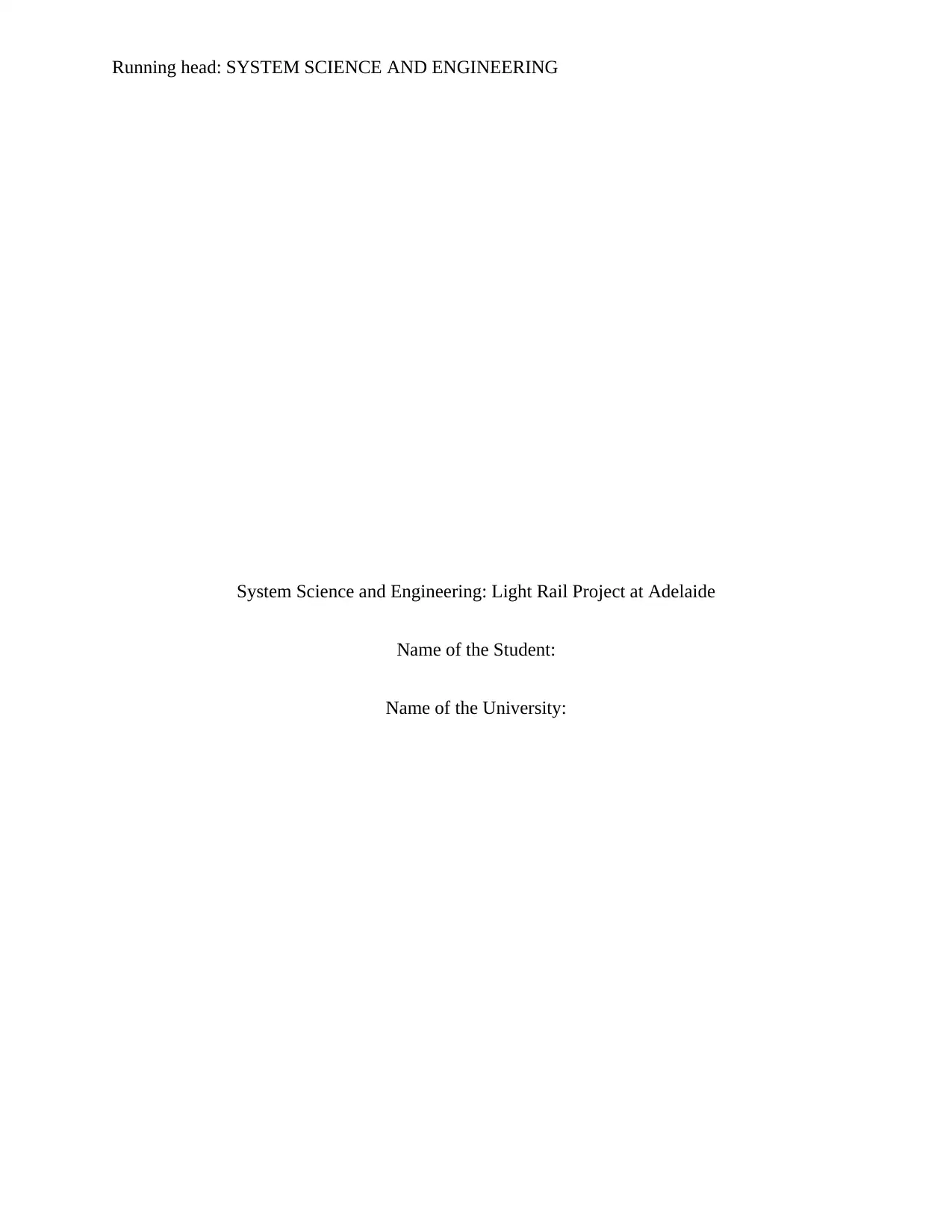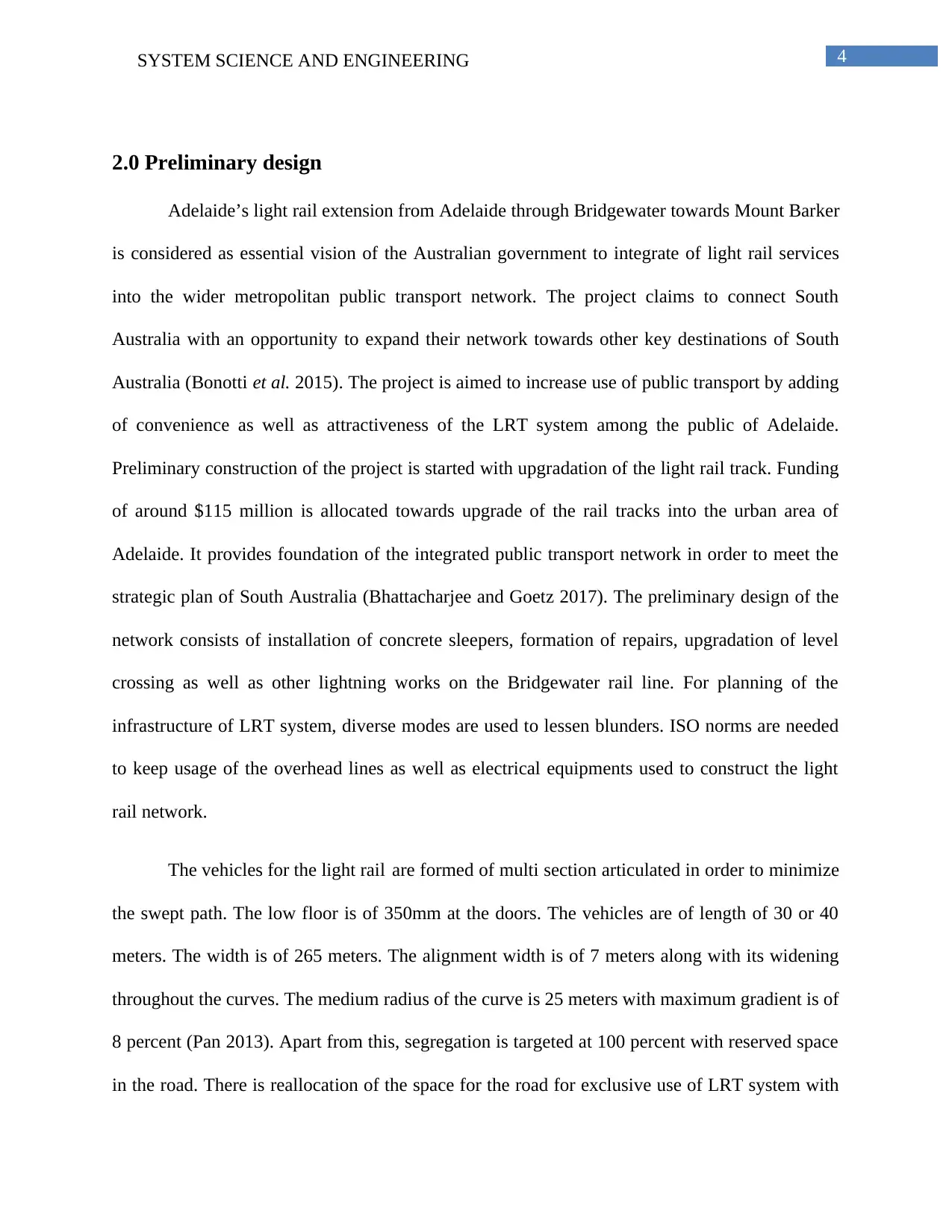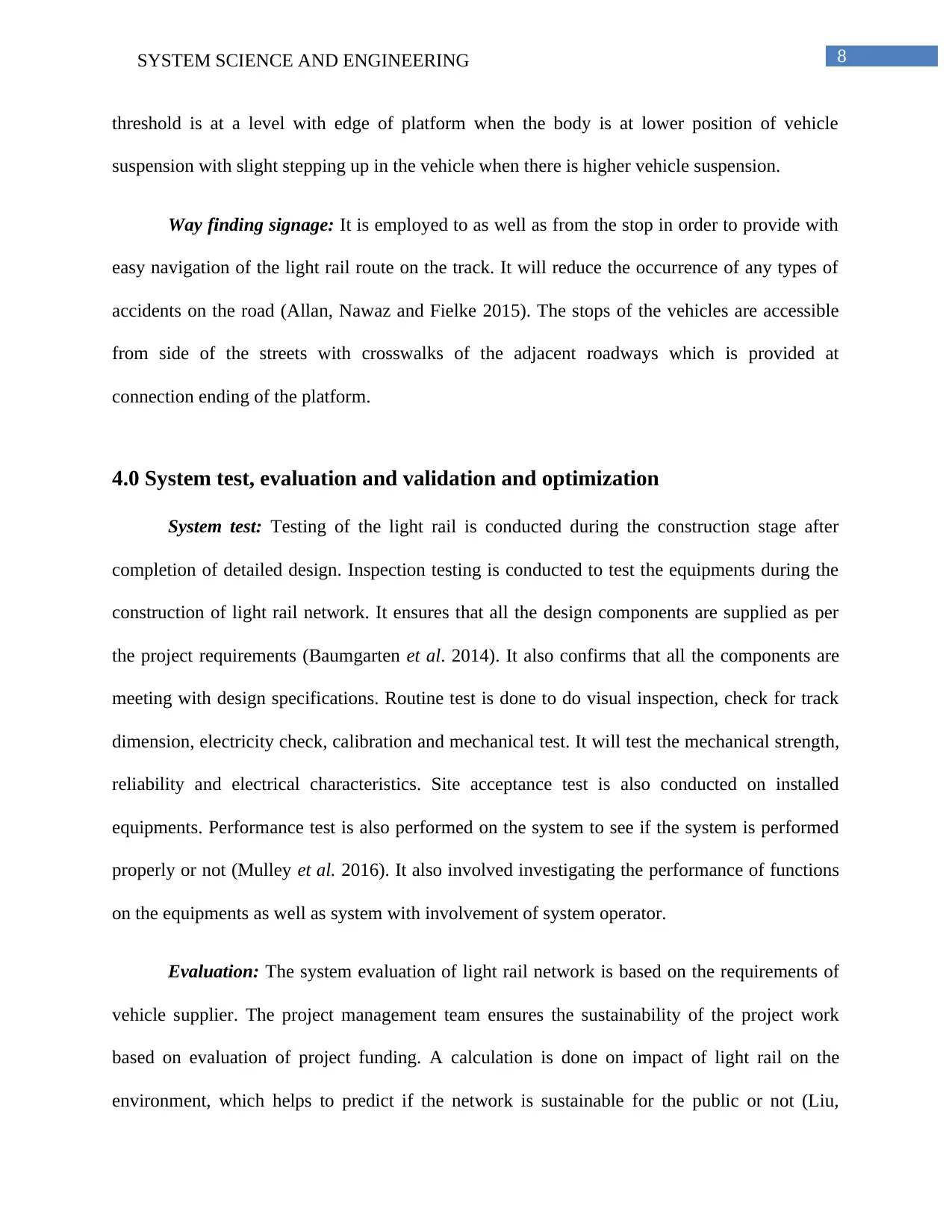Adelaide Light Rail Project: Preliminary Design and System Analysis
VerifiedAdded on 2020/03/16
|13
|3086
|222
Report
AI Summary
This report provides a comprehensive analysis of the Adelaide light rail project, focusing on the preliminary design, detailed design and development, and system testing, evaluation, validation, and optimization. The project aims to upgrade and expand the existing light rail network, reducing traffic congestion and promoting the use of public transport. The report details the design of overhead lines, traction power substations, platforms, and wayfinding signage. It also covers system testing procedures, evaluation methods, validation processes using CAD and simulation software, and optimization strategies for station locations and track alignment. The project's goal is to create an efficient and sustainable light rail system for the population of South Australia.

Running head: SYSTEM SCIENCE AND ENGINEERING
System Science and Engineering: Light Rail Project at Adelaide
Name of the Student:
Name of the University:
System Science and Engineering: Light Rail Project at Adelaide
Name of the Student:
Name of the University:
Paraphrase This Document
Need a fresh take? Get an instant paraphrase of this document with our AI Paraphraser

1SYSTEM SCIENCE AND ENGINEERING
Executive Summary
The report is based on preliminary design of a light rail network for Adelaide with upgradation
as well as expansion of their light rail network. The network helps to reduce traffic and also
congestion on the road. System testing, evaluation, validation and optimization of the network
are also done to investigate if the system is implemented properly or not. Preliminary design of
the network consists of design of the overhead lines, traction power substations, platforms and
way finding signage which is based on stop type, location and surrounding of the construction
area.
Executive Summary
The report is based on preliminary design of a light rail network for Adelaide with upgradation
as well as expansion of their light rail network. The network helps to reduce traffic and also
congestion on the road. System testing, evaluation, validation and optimization of the network
are also done to investigate if the system is implemented properly or not. Preliminary design of
the network consists of design of the overhead lines, traction power substations, platforms and
way finding signage which is based on stop type, location and surrounding of the construction
area.

2SYSTEM SCIENCE AND ENGINEERING
Table of Contents
1.0 Introduction................................................................................................................................3
2.0 Preliminary design.....................................................................................................................4
3.0 Detailed design and development..............................................................................................6
4.0 System test, evaluation and validation and optimization...........................................................8
5.0 Conclusion.................................................................................................................................9
References......................................................................................................................................11
Table of Contents
1.0 Introduction................................................................................................................................3
2.0 Preliminary design.....................................................................................................................4
3.0 Detailed design and development..............................................................................................6
4.0 System test, evaluation and validation and optimization...........................................................8
5.0 Conclusion.................................................................................................................................9
References......................................................................................................................................11
⊘ This is a preview!⊘
Do you want full access?
Subscribe today to unlock all pages.

Trusted by 1+ million students worldwide

3SYSTEM SCIENCE AND ENGINEERING
1.0 Introduction
The light rail project of Adelaide is a public transport system for the capital city of South
Australia. From the year 2003, the public transport of Adelaide is shifted focused on the light rail
transit technology. It becomes a substantial upgradation as well as expansion programs. The
scope of this project is to establish a head electric wires, track the installation route of the light
rail and draw a blueprint of the light rail transit (LRT) systems. The main aim of construction of
light rail is to reduce the traffic into the road, reduction of contamination within the city and use
of advanced technology for development of Adelaide city. The track of the light rail network is
extended on from the Adelaide through Bridgewater towards Mount Barker. There is an
upgradation of existing tramline infrastructure as well as its services. The entire project is
installed of tramline overhead of wiring as well as safety works.
The report analyzes the light rail project of Adelaide by conducting preliminary design of
the system with help of smart technology. It is the first phase of the designing process that is
used to investigate the layout of existing areas of the light rail network. In this particular
assignment task, the entire system configuration of light rail network is defined with its layouts
of the project which provides with early configurations of this project. This particular report is
helpful to investigate on the system design of the light rail as a public transport medium.
Detailed design and development are also summarized to make a proper understanding of the
network to support implications of design concepts. The report also highlights on the system test,
validation, evaluation and optimization of the light rail network so that it provides a effective
public transport to the population of Adelaide.
1.0 Introduction
The light rail project of Adelaide is a public transport system for the capital city of South
Australia. From the year 2003, the public transport of Adelaide is shifted focused on the light rail
transit technology. It becomes a substantial upgradation as well as expansion programs. The
scope of this project is to establish a head electric wires, track the installation route of the light
rail and draw a blueprint of the light rail transit (LRT) systems. The main aim of construction of
light rail is to reduce the traffic into the road, reduction of contamination within the city and use
of advanced technology for development of Adelaide city. The track of the light rail network is
extended on from the Adelaide through Bridgewater towards Mount Barker. There is an
upgradation of existing tramline infrastructure as well as its services. The entire project is
installed of tramline overhead of wiring as well as safety works.
The report analyzes the light rail project of Adelaide by conducting preliminary design of
the system with help of smart technology. It is the first phase of the designing process that is
used to investigate the layout of existing areas of the light rail network. In this particular
assignment task, the entire system configuration of light rail network is defined with its layouts
of the project which provides with early configurations of this project. This particular report is
helpful to investigate on the system design of the light rail as a public transport medium.
Detailed design and development are also summarized to make a proper understanding of the
network to support implications of design concepts. The report also highlights on the system test,
validation, evaluation and optimization of the light rail network so that it provides a effective
public transport to the population of Adelaide.
Paraphrase This Document
Need a fresh take? Get an instant paraphrase of this document with our AI Paraphraser

4SYSTEM SCIENCE AND ENGINEERING
2.0 Preliminary design
Adelaide’s light rail extension from Adelaide through Bridgewater towards Mount Barker
is considered as essential vision of the Australian government to integrate of light rail services
into the wider metropolitan public transport network. The project claims to connect South
Australia with an opportunity to expand their network towards other key destinations of South
Australia (Bonotti et al. 2015). The project is aimed to increase use of public transport by adding
of convenience as well as attractiveness of the LRT system among the public of Adelaide.
Preliminary construction of the project is started with upgradation of the light rail track. Funding
of around $115 million is allocated towards upgrade of the rail tracks into the urban area of
Adelaide. It provides foundation of the integrated public transport network in order to meet the
strategic plan of South Australia (Bhattacharjee and Goetz 2017). The preliminary design of the
network consists of installation of concrete sleepers, formation of repairs, upgradation of level
crossing as well as other lightning works on the Bridgewater rail line. For planning of the
infrastructure of LRT system, diverse modes are used to lessen blunders. ISO norms are needed
to keep usage of the overhead lines as well as electrical equipments used to construct the light
rail network.
The vehicles for the light rail are formed of multi section articulated in order to minimize
the swept path. The low floor is of 350mm at the doors. The vehicles are of length of 30 or 40
meters. The width is of 265 meters. The alignment width is of 7 meters along with its widening
throughout the curves. The medium radius of the curve is 25 meters with maximum gradient is of
8 percent (Pan 2013). Apart from this, segregation is targeted at 100 percent with reserved space
in the road. There is reallocation of the space for the road for exclusive use of LRT system with
2.0 Preliminary design
Adelaide’s light rail extension from Adelaide through Bridgewater towards Mount Barker
is considered as essential vision of the Australian government to integrate of light rail services
into the wider metropolitan public transport network. The project claims to connect South
Australia with an opportunity to expand their network towards other key destinations of South
Australia (Bonotti et al. 2015). The project is aimed to increase use of public transport by adding
of convenience as well as attractiveness of the LRT system among the public of Adelaide.
Preliminary construction of the project is started with upgradation of the light rail track. Funding
of around $115 million is allocated towards upgrade of the rail tracks into the urban area of
Adelaide. It provides foundation of the integrated public transport network in order to meet the
strategic plan of South Australia (Bhattacharjee and Goetz 2017). The preliminary design of the
network consists of installation of concrete sleepers, formation of repairs, upgradation of level
crossing as well as other lightning works on the Bridgewater rail line. For planning of the
infrastructure of LRT system, diverse modes are used to lessen blunders. ISO norms are needed
to keep usage of the overhead lines as well as electrical equipments used to construct the light
rail network.
The vehicles for the light rail are formed of multi section articulated in order to minimize
the swept path. The low floor is of 350mm at the doors. The vehicles are of length of 30 or 40
meters. The width is of 265 meters. The alignment width is of 7 meters along with its widening
throughout the curves. The medium radius of the curve is 25 meters with maximum gradient is of
8 percent (Pan 2013). Apart from this, segregation is targeted at 100 percent with reserved space
in the road. There is reallocation of the space for the road for exclusive use of LRT system with

5SYSTEM SCIENCE AND ENGINEERING
proper road levels to meet with local requirements of length of the network routes. The project
provides 100 percent priority to the signaled intersections by designing proper way finding
signals at the intersections for doing proper rail construction (Ruming, Mee and McGuirk 20160.
Automatic vehicle location system is also designed to provide priority to signaled intersections
which help to reduce time of the entire journey as well as superior journey time dependability.
Figure 1: Light Rail Network at Adelaide
(Source: Currie and Delbosc 2014, pp-147)
The height of the platform is 350mm above the rail with end ramps at 5 percent gradient.
The platforms are step free access with fully integrated pedestrian areas wherever it is possible.
The length of the platform is such that a longest vehicle can stop. The width of the platform is
considered as well as designed as 3 meters (side platform) continued by 4 meters (island
proper road levels to meet with local requirements of length of the network routes. The project
provides 100 percent priority to the signaled intersections by designing proper way finding
signals at the intersections for doing proper rail construction (Ruming, Mee and McGuirk 20160.
Automatic vehicle location system is also designed to provide priority to signaled intersections
which help to reduce time of the entire journey as well as superior journey time dependability.
Figure 1: Light Rail Network at Adelaide
(Source: Currie and Delbosc 2014, pp-147)
The height of the platform is 350mm above the rail with end ramps at 5 percent gradient.
The platforms are step free access with fully integrated pedestrian areas wherever it is possible.
The length of the platform is such that a longest vehicle can stop. The width of the platform is
considered as well as designed as 3 meters (side platform) continued by 4 meters (island
⊘ This is a preview!⊘
Do you want full access?
Subscribe today to unlock all pages.

Trusted by 1+ million students worldwide

6SYSTEM SCIENCE AND ENGINEERING
platform). The stops of the vehicles are integrated with the existing pedestrian crosswalks at the
intersections. Again, the stop infrastructure is provided an image of the LRT system with stop
elements consists of seating, ticketing, and help points, announcements for the passengers,
CCTV, branding, real time and passenger information and shelters (Stow et al. 2017).
Figure 2: Preliminary design of light rail transit system
(Source: Mulley et al. 2016, pp-49)
3.0 Detailed design and development
The light rail network of Adelaide consists of the following designing equipments to
construct an effective and sustainable LRT system for the population of South Australia. The
design of the overhead lines, traction power substations, platforms and way finding signage are
based on stop type, location and surrounding of the light rail network as well as functions (Kim
and Lahr 2014). Detailed design of the light rail network of Adelaide is summarized as follows:
platform). The stops of the vehicles are integrated with the existing pedestrian crosswalks at the
intersections. Again, the stop infrastructure is provided an image of the LRT system with stop
elements consists of seating, ticketing, and help points, announcements for the passengers,
CCTV, branding, real time and passenger information and shelters (Stow et al. 2017).
Figure 2: Preliminary design of light rail transit system
(Source: Mulley et al. 2016, pp-49)
3.0 Detailed design and development
The light rail network of Adelaide consists of the following designing equipments to
construct an effective and sustainable LRT system for the population of South Australia. The
design of the overhead lines, traction power substations, platforms and way finding signage are
based on stop type, location and surrounding of the light rail network as well as functions (Kim
and Lahr 2014). Detailed design of the light rail network of Adelaide is summarized as follows:
Paraphrase This Document
Need a fresh take? Get an instant paraphrase of this document with our AI Paraphraser

7SYSTEM SCIENCE AND ENGINEERING
Overhead lines: LRT system of Adelaide needs electric power supply with the vehicles is
powered via the overhead lines. The overhead lines which provide of electric power to the
vehicles of light rail are considered as an integral alignment route. LRT system is much lighter
and it consists of elegant design which would minimize the impacts of the post, contract wire as
well as electrical feeding (Dziauddin, Powe and Alvanides 2015). In South Australia, the heights
of the wire is approximately 4.2 meters which is above the rail level used for the LRT system
into the streets. Lower height of wire is considered where the routes are segregated from the
vehicles. Overhead lines are located at side of the alignment of LRT or it will locate between two
tracks (Nelson et al. 2015). Street lights as well as other electrical equipments are designed in
such a way that it can be maintained safety without hampering the LRT system. A light grey
color or any metallic would reflect the finish of the overhead poles.
Traction power substations (TPSS): LRT system consists of TPSS at the intervals along
with the route towards step down the higher voltage of AC supply to 750V of DC which is to be
fed on the overhead line. Exterior design of the substations is made based on the surroundings
(Brown et al. 2015). The location is followed to access maintenance and proper fire services
access. Signal controlling equipments are also integrated with the traffic signal controlling as
well as design of the cabinets is also followed the practice of city of Adelaide.
Design of platforms: The position as well as height of the platform is provided with step
free and in addition to gap free boarding among the edge of the platform along with the vehicle
door threshold (Ransom and Kelemen 2016). For the LRT system, the horizontal clearance is to
be specified as 40mm in order to permit tolerances into the construction of track as well as
platforms (Currie and Delbosc 2013). The design of the platform should be such that the door
Overhead lines: LRT system of Adelaide needs electric power supply with the vehicles is
powered via the overhead lines. The overhead lines which provide of electric power to the
vehicles of light rail are considered as an integral alignment route. LRT system is much lighter
and it consists of elegant design which would minimize the impacts of the post, contract wire as
well as electrical feeding (Dziauddin, Powe and Alvanides 2015). In South Australia, the heights
of the wire is approximately 4.2 meters which is above the rail level used for the LRT system
into the streets. Lower height of wire is considered where the routes are segregated from the
vehicles. Overhead lines are located at side of the alignment of LRT or it will locate between two
tracks (Nelson et al. 2015). Street lights as well as other electrical equipments are designed in
such a way that it can be maintained safety without hampering the LRT system. A light grey
color or any metallic would reflect the finish of the overhead poles.
Traction power substations (TPSS): LRT system consists of TPSS at the intervals along
with the route towards step down the higher voltage of AC supply to 750V of DC which is to be
fed on the overhead line. Exterior design of the substations is made based on the surroundings
(Brown et al. 2015). The location is followed to access maintenance and proper fire services
access. Signal controlling equipments are also integrated with the traffic signal controlling as
well as design of the cabinets is also followed the practice of city of Adelaide.
Design of platforms: The position as well as height of the platform is provided with step
free and in addition to gap free boarding among the edge of the platform along with the vehicle
door threshold (Ransom and Kelemen 2016). For the LRT system, the horizontal clearance is to
be specified as 40mm in order to permit tolerances into the construction of track as well as
platforms (Currie and Delbosc 2013). The design of the platform should be such that the door

8SYSTEM SCIENCE AND ENGINEERING
threshold is at a level with edge of platform when the body is at lower position of vehicle
suspension with slight stepping up in the vehicle when there is higher vehicle suspension.
Way finding signage: It is employed to as well as from the stop in order to provide with
easy navigation of the light rail route on the track. It will reduce the occurrence of any types of
accidents on the road (Allan, Nawaz and Fielke 2015). The stops of the vehicles are accessible
from side of the streets with crosswalks of the adjacent roadways which is provided at
connection ending of the platform.
4.0 System test, evaluation and validation and optimization
System test: Testing of the light rail is conducted during the construction stage after
completion of detailed design. Inspection testing is conducted to test the equipments during the
construction of light rail network. It ensures that all the design components are supplied as per
the project requirements (Baumgarten et al. 2014). It also confirms that all the components are
meeting with design specifications. Routine test is done to do visual inspection, check for track
dimension, electricity check, calibration and mechanical test. It will test the mechanical strength,
reliability and electrical characteristics. Site acceptance test is also conducted on installed
equipments. Performance test is also performed on the system to see if the system is performed
properly or not (Mulley et al. 2016). It also involved investigating the performance of functions
on the equipments as well as system with involvement of system operator.
Evaluation: The system evaluation of light rail network is based on the requirements of
vehicle supplier. The project management team ensures the sustainability of the project work
based on evaluation of project funding. A calculation is done on impact of light rail on the
environment, which helps to predict if the network is sustainable for the public or not (Liu,
threshold is at a level with edge of platform when the body is at lower position of vehicle
suspension with slight stepping up in the vehicle when there is higher vehicle suspension.
Way finding signage: It is employed to as well as from the stop in order to provide with
easy navigation of the light rail route on the track. It will reduce the occurrence of any types of
accidents on the road (Allan, Nawaz and Fielke 2015). The stops of the vehicles are accessible
from side of the streets with crosswalks of the adjacent roadways which is provided at
connection ending of the platform.
4.0 System test, evaluation and validation and optimization
System test: Testing of the light rail is conducted during the construction stage after
completion of detailed design. Inspection testing is conducted to test the equipments during the
construction of light rail network. It ensures that all the design components are supplied as per
the project requirements (Baumgarten et al. 2014). It also confirms that all the components are
meeting with design specifications. Routine test is done to do visual inspection, check for track
dimension, electricity check, calibration and mechanical test. It will test the mechanical strength,
reliability and electrical characteristics. Site acceptance test is also conducted on installed
equipments. Performance test is also performed on the system to see if the system is performed
properly or not (Mulley et al. 2016). It also involved investigating the performance of functions
on the equipments as well as system with involvement of system operator.
Evaluation: The system evaluation of light rail network is based on the requirements of
vehicle supplier. The project management team ensures the sustainability of the project work
based on evaluation of project funding. A calculation is done on impact of light rail on the
environment, which helps to predict if the network is sustainable for the public or not (Liu,
⊘ This is a preview!⊘
Do you want full access?
Subscribe today to unlock all pages.

Trusted by 1+ million students worldwide

9SYSTEM SCIENCE AND ENGINEERING
Fagnant and Zhang 2016). It is evaluated that due to implementation of light rail network, it will
reduce the emissions of greenhouse gases from the public transport. There is reduction of energy
consumption. The emissions of gases are reduced by 8 percent in the year 2025 as well as
approximately 15 percent by the year 2035.
Validation: CAD is used to form of the 3D display of the light rail network. Therefore,
proper validation is required for CAD and simulation software such as NETSIM for the purpose
to model LRT system. The models are validated to produce accurate estimation of the stopped
delay as well as percentage stop at individual intersections into the network. The models are
proper and accurate estimation of the network travel times (Kim and Lahr 2014). The models are
performed to stimulate the controlled impacts as well as behavior of the LRT system into
modeled systems.
Optimization: It is required to optimize the locations of the stations as well as alignment
of track for the rail transit line. There is development of special algorithms which allow
optimization of alignment in order to take advantage of the links into existing network for the
reduction of construction cost and in addition to account for the disturbances of the traffic on the
roadway (Pan 2013). The transit planner should produce an optimized alternative for the design
of the station location and alignment of track. The models used are optimized the vertical
alignment as well as speed and also coasting distances.
5.0 Conclusion
It is concluded that the light rail network for population of South Australia will help to
reduce congestion at the road and reduces the traffic into city of Adelaide. Development of the
light rail framework with use of advanced technology helps to mitigate the problems and issues
Fagnant and Zhang 2016). It is evaluated that due to implementation of light rail network, it will
reduce the emissions of greenhouse gases from the public transport. There is reduction of energy
consumption. The emissions of gases are reduced by 8 percent in the year 2025 as well as
approximately 15 percent by the year 2035.
Validation: CAD is used to form of the 3D display of the light rail network. Therefore,
proper validation is required for CAD and simulation software such as NETSIM for the purpose
to model LRT system. The models are validated to produce accurate estimation of the stopped
delay as well as percentage stop at individual intersections into the network. The models are
proper and accurate estimation of the network travel times (Kim and Lahr 2014). The models are
performed to stimulate the controlled impacts as well as behavior of the LRT system into
modeled systems.
Optimization: It is required to optimize the locations of the stations as well as alignment
of track for the rail transit line. There is development of special algorithms which allow
optimization of alignment in order to take advantage of the links into existing network for the
reduction of construction cost and in addition to account for the disturbances of the traffic on the
roadway (Pan 2013). The transit planner should produce an optimized alternative for the design
of the station location and alignment of track. The models used are optimized the vertical
alignment as well as speed and also coasting distances.
5.0 Conclusion
It is concluded that the light rail network for population of South Australia will help to
reduce congestion at the road and reduces the traffic into city of Adelaide. Development of the
light rail framework with use of advanced technology helps to mitigate the problems and issues
Paraphrase This Document
Need a fresh take? Get an instant paraphrase of this document with our AI Paraphraser

10SYSTEM SCIENCE AND ENGINEERING
related to traffic. The light rail network also reduces the journey time of the public. The
preliminary design of the network consists of design of tracks, signals as well as platforms.
Before implementation of this project, design is prepared which is investigated by the Australian
government. The benefits behind implementation of light rail network are lessening of traffic and
congestions, decrease of pollution and development of smarter city. The layout of the track is
proper which is beneficial for efficient development of the sustainable light rail system. Light
rail’s speed is increased based on controlling of the signal and maintenance of the rail track. It
will reduce the occurrence of accidents on the road and makes a proper LRT system for the
public of Adelaide city. Height, width, length of the platforms, positioning of the signals side the
track and at the interactions is also required for an efficient LRT framework.
related to traffic. The light rail network also reduces the journey time of the public. The
preliminary design of the network consists of design of tracks, signals as well as platforms.
Before implementation of this project, design is prepared which is investigated by the Australian
government. The benefits behind implementation of light rail network are lessening of traffic and
congestions, decrease of pollution and development of smarter city. The layout of the track is
proper which is beneficial for efficient development of the sustainable light rail system. Light
rail’s speed is increased based on controlling of the signal and maintenance of the rail track. It
will reduce the occurrence of accidents on the road and makes a proper LRT system for the
public of Adelaide city. Height, width, length of the platforms, positioning of the signals side the
track and at the interactions is also required for an efficient LRT framework.

11SYSTEM SCIENCE AND ENGINEERING
References
Allan, A., Nawaz, M. and Fielke, M., 2015. Transforming Adelaide into a city of networked
TODs using buses: case study of the Adelaide OBahn. Australasian Transport Research Forum.
Baumgarten, B., Bernard, M., Robin, P. and Rotarescu, L., 2014. Reducing cost of a tram system
for smaller urban areas. CORE 2014: Rail Transport For A Vital Economy, p.42.
Bhattacharjee, S. and Goetz, A.R., 2017. Response to “The impact of light rail on congestion in
Denver: A reappraisal”. Journal of Transport Geography, 58, pp.269-271.
Bonotti, R., Rossetti, S., Tiboni, M. and Tira, M., 2015. Analysing Space-Time Accessibility
Towards the Implementation of the Light Rail System: The Case Study of Brescia. Planning
Practice & Research, 30(4), pp.424-442.
Brown, B.B., Werner, C.M., Tribby, C.P., Miller, H.J. and Smith, K.R., 2015. Transit use,
physical activity, and body mass index changes: objective measures associated with complete
street light-rail construction. American journal of public health, 105(7), pp.1468-1474.
Currie, G. and Delbosc, A., 2013. Exploring comparative ridership drivers of bus rapid transit
and light rail transit routes. Journal of Public Transportation, 16(2), p.3.
Currie, G. and Delbosc, A., 2014. Assessing bus rapid transit system performance in
Australasia. Research in Transportation Economics, 48, pp.142-151.
Dziauddin, M.F., Powe, N. and Alvanides, S., 2015. Estimating the effects of light rail transit
(LRT) system on residential property values using geographically weighted regression
(GWR). Applied Spatial Analysis and Policy, 8(1), pp.1-25.
References
Allan, A., Nawaz, M. and Fielke, M., 2015. Transforming Adelaide into a city of networked
TODs using buses: case study of the Adelaide OBahn. Australasian Transport Research Forum.
Baumgarten, B., Bernard, M., Robin, P. and Rotarescu, L., 2014. Reducing cost of a tram system
for smaller urban areas. CORE 2014: Rail Transport For A Vital Economy, p.42.
Bhattacharjee, S. and Goetz, A.R., 2017. Response to “The impact of light rail on congestion in
Denver: A reappraisal”. Journal of Transport Geography, 58, pp.269-271.
Bonotti, R., Rossetti, S., Tiboni, M. and Tira, M., 2015. Analysing Space-Time Accessibility
Towards the Implementation of the Light Rail System: The Case Study of Brescia. Planning
Practice & Research, 30(4), pp.424-442.
Brown, B.B., Werner, C.M., Tribby, C.P., Miller, H.J. and Smith, K.R., 2015. Transit use,
physical activity, and body mass index changes: objective measures associated with complete
street light-rail construction. American journal of public health, 105(7), pp.1468-1474.
Currie, G. and Delbosc, A., 2013. Exploring comparative ridership drivers of bus rapid transit
and light rail transit routes. Journal of Public Transportation, 16(2), p.3.
Currie, G. and Delbosc, A., 2014. Assessing bus rapid transit system performance in
Australasia. Research in Transportation Economics, 48, pp.142-151.
Dziauddin, M.F., Powe, N. and Alvanides, S., 2015. Estimating the effects of light rail transit
(LRT) system on residential property values using geographically weighted regression
(GWR). Applied Spatial Analysis and Policy, 8(1), pp.1-25.
⊘ This is a preview!⊘
Do you want full access?
Subscribe today to unlock all pages.

Trusted by 1+ million students worldwide
1 out of 13
Related Documents
Your All-in-One AI-Powered Toolkit for Academic Success.
+13062052269
info@desklib.com
Available 24*7 on WhatsApp / Email
![[object Object]](/_next/static/media/star-bottom.7253800d.svg)
Unlock your academic potential
Copyright © 2020–2025 A2Z Services. All Rights Reserved. Developed and managed by ZUCOL.





